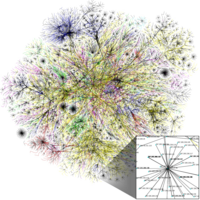
Photo from wikipedia
To enable user diversity and multiplexing gains, a fully digital precoding multiple-input–multiple-output (MIMO) architecture is typically applied. However, a large number of radio frequency (RF) chains make the system unrealistic… Click to show full abstract
To enable user diversity and multiplexing gains, a fully digital precoding multiple-input–multiple-output (MIMO) architecture is typically applied. However, a large number of radio frequency (RF) chains make the system unrealistic to low-cost communications. Therefore, a practical three-stage hybrid analog–digital precoding architecture, occupying fewer RF chains, is proposed aiming for a nonorthogonal Internet of Things (IoT) signal in low-cost multiuser MIMO systems. The nonorthogonal waveform can flexibly save spectral resources for massive devices connections or improve data rate without consuming extra spectral resources. The hybrid precoding is divided into three stages, including analog domain, digital domain, and waveform domain. A codebook-based beam selection simplifies the analog-domain beamforming via phase-only tuning. Digital-domain precoding can fine-tune the codebook shaped beam and resolve multiuser interference in terms of both signal amplitude and phase. In the end, the waveform-domain precoding manages the self-created intercarrier interference (ICI) of the nonorthogonal signal. This article designs over-the-air signal transmission experiments for fully digital and hybrid precoding systems on software-defined radio (SDR) devices. Results reveal that waveform precoding accuracy can be enhanced by hybrid precoding. Compared to a transmitter with the same RF chain resources, hybrid precoding significantly outperforms fully digital precoding by up to 15.6 dB error vector magnitude (EVM) gain. A fully digital system with the same number of antennas clearly requires more RF chains and, therefore, is low power, space-efficient, and cost-efficient. Therefore, the proposed three-stage hybrid precoding is a quite suitable solution to nonorthogonal IoT applications.
Journal Title: IEEE Internet of Things Journal
Year Published: 2020
Link to full text (if available)
Share on Social Media: Sign Up to like & get
recommendations!